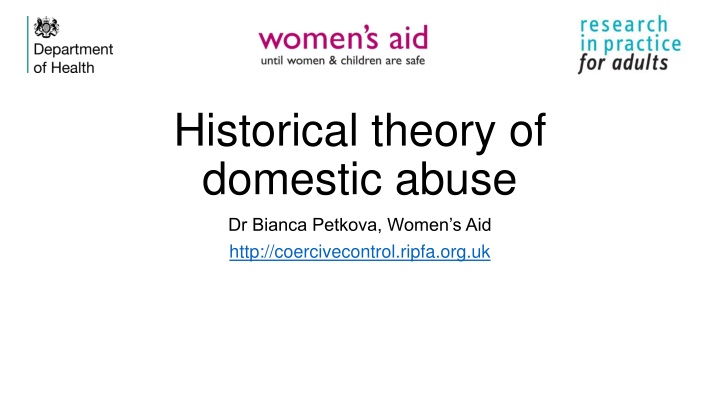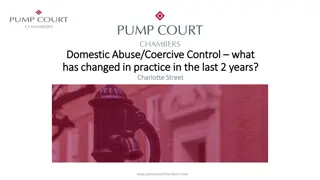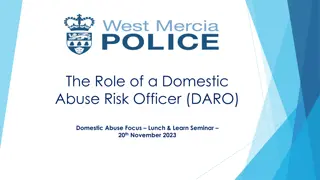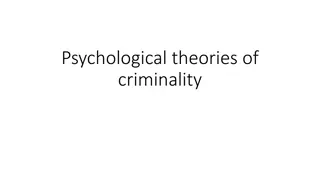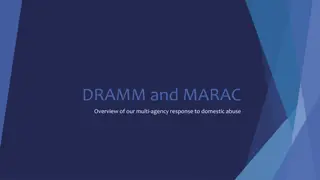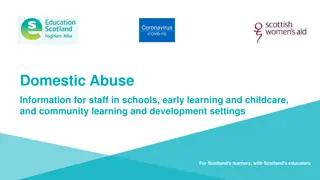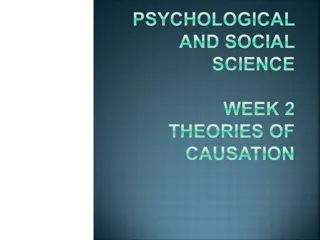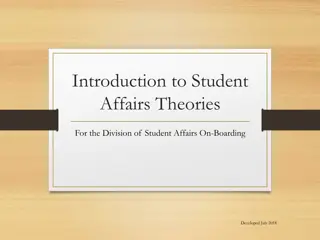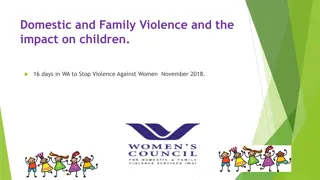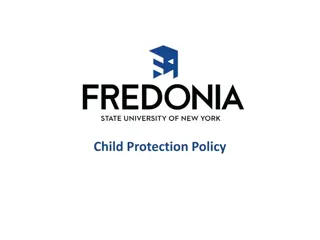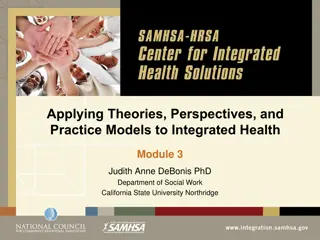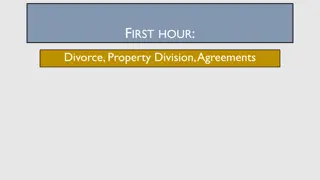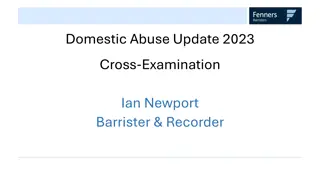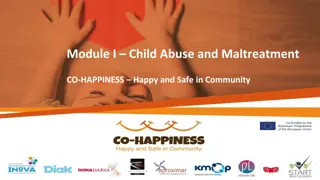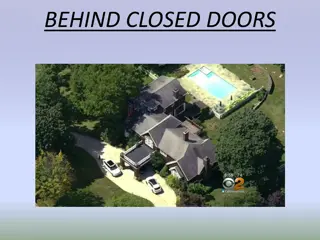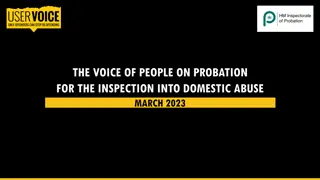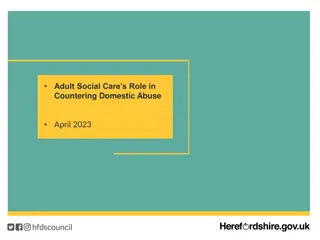Historical Theory of Domestic Abuse: Exploring Theories and Models
Dr. Bianca Petkova from Women's Aid discusses various theories on domestic abuse, including psychoanalytic, social learning, feminist, and ecological models, highlighting the importance of understanding the different perspectives to address and combat domestic violence effectively.
Download Presentation

Please find below an Image/Link to download the presentation.
The content on the website is provided AS IS for your information and personal use only. It may not be sold, licensed, or shared on other websites without obtaining consent from the author.If you encounter any issues during the download, it is possible that the publisher has removed the file from their server.
You are allowed to download the files provided on this website for personal or commercial use, subject to the condition that they are used lawfully. All files are the property of their respective owners.
The content on the website is provided AS IS for your information and personal use only. It may not be sold, licensed, or shared on other websites without obtaining consent from the author.
E N D
Presentation Transcript
Historical theory of domestic abuse Dr Bianca Petkova, Women s Aid http://coercivecontrol.ripfa.org.uk
Theoretical understanding and practice The way we understand domestic abuse (DA) informs what we do about it. If we understand DA as the problem of faulty individuals - we might try to fix, control or punish these individuals. If we understand DA as a family issue we might try to correct family dynamics. If we see DA as a social problem we might try to change ourselves and the world we live in.
Theories about domestic abuse state it is due to Some examples: Psychoanalytic approaches, (masochistic tendencies in women, fragile masculine identities, Oedipal complex issues, Big M theory etc.) Social learning theory (learning; modelling, reinforcement, rewards, 'intergenerational cycle of abuse; learnt helplessness etc.) Personality traits / disorders (e.g. narcissistic personality; psychopathology, PTSD etc.) Family conflict theories (e.g. role conflicts, conflict over scare recourses, provocation general strain theory , etc.) Attachment theories (enacting insecure attachments , trauma bonding , Stockholm syndrome etc.) Biological and evolutionary factors (biological sex predispositions, hormones, innate drives, mate retention theory etc.) Ecological model (connects domestic violence with individual, relationships, family, community & societal factors) Feminist theories - (domestic abuse is an expression of women s oppression in society & it is a means of maintaining gender inequality) Intersectionality (domestic abuse should be understood by combining gendered axes of power with others such as race, dis/ability, age, class, sexuality)
Theories of DA can be organised in 3 main groups: Individual centred Family centred Socio - cultural
Ecological model of domestic abuse Bronfenbrenner U (1979) Ecology of Human Development: Experiments by Nature and Design. Cambridge: Harvard Univ. Press. Cited in Dahlberg LL, Krug EG (2002) Violence-a global public health problem . In Krug E, Dahlberg LL, Mercy JA, Zwi AB, Lozano R (eds) (2002) World Report on Violence and Health. Geneva, Switzerland: World Health Organization.
Ecological model of domestic abuse Individual - biological and personal history factors; such as age, education, income, substance use, or history of abuse, that increase the likelihood of becoming a victim or perpetrator of violence. Relationship -Examines close relationships that may increase the risk of experiencing violence as a victim or perpetrator. A person s closest social circle-peers, partners and family members-influences their behaviour and contributes to their range of experience. Community - Explores the settings, such as schools, workplaces, and neighbourhoods, in which social relationships occur and seeks to identify the characteristics of these settings that are associated with becoming victims or perpetrators of violence. Societal - Looks at the broad societal factors, such as health, economic, educational and social policies, that help create a climate in which violence is encouraged or inhibited and help to maintain economic or social inequalities between groups in society.
How did it all begin? - Historical roots to domestic abuse explanations
Long western tradition of legitimising control & violence against women within the family Roman law gave men the right to chastise their wives, even to the point of death. (Stedman B (1917) Right of Husband to Chastise Wife . Virginia Law Register 3 (4) 241). Until late nineteenth century, English common law gave the husband the right to command his wife s obedience, and subject her to corporal punishment or chastisement if she defied his authority. (Tuerkheimer, 2004, citing Siegel, 1996) 1857, Rule of Thumb A judge reportedly states that a man may beat his wife so long as he uses 'a rod not thicker than his thumb'. Many people consider this to be common law throughout the 19th century.
1960s The term domestic violence did not exist. Judges and police officers viewed wife beating as a trivial offense both would tell husbands to calm down and wives to stop annoying them. Psychiatrists saw DA as a pathology of individual (defective) men and women.
1970s + Biology normalising male abuse women are naturally (i.e. biologically) programmed to be quiet and passive, while men are wired biologically to be aggressive and dominant. By this they meant that men and women are biologically predisposed to be different, to the extent that women are quiet while men are aggressive . (Tiger and Fox, 1972)
More justifications of male abuse in nearly 75 % of the cases involving serious marital discord, particularly wife beating, the abuser typically reveals an abnormal blood glucose level . (Hungerford cited in Dobash & Dobash, 1992: 236) the primitive rage reactions leading to aggression and battering are .instinctual patterns. Angry and aggressive responses are wired in the mammalian brain... (Deschner JP (1984) The Hitting Habit. New York Free Press) Buss (1988) argues that males have developed strategies for mate retention. These include direct guarding, (restricting her movements) of the female and negative inducements to prevent her straying (financial control, threat of violence if they are unfaithful or even so much as look at another man, etc.)
1970s - Victim blaming the victim in spouse assaults can always be assumed to have played a crucial role in the offence, and may have directly or indirectly brought about or precipitated their own victimisation (Schultz L G (1960) The wife assaulter . Journal of Social Therapy 6. (2) 103- 12.) the victim is the one who is acting out, initiating the interaction between her and the offender, and by her behaviour she generates the potentiality for criminal behaviour of the offender and triggers this potentiality, if it exists before in him. (Amir M (1971) Patterns of Forcible Rape. Univ. of Chicago Press, 259)
What is surprising is the enormous effort to explain male behaviour by examining characteristics of women. (Hotaling and Sugarman, 1986)
1970s also marked the beginning of the womens movement The movement questioned gender roles, (i.e. that men should be in control of women in the family and in generally; it produced in depth analysis of gender & power). The movement produced evidence that DA of women was prevalent , (Women s Aid coined the term domestic abuse & the UK government accepted it.). DA could no longer be explained away easily by faulty individuals or dysfunctional families it was endemic to society. Out of this work- Women s Aid refuges for DA abuse victims came into being.
1970s and 1980s Lenore Walker cycle of violence * 15
Criticisms: It doesn t show intention (to exercise power & control as a motivating factor for perpetrators). Many women don't experience honeymoon period (culture also important). Many women exist in a state of an ongoing fear & anxiety and experience unrelenting control over every aspect of their lives Dobash & Dobash, 1992:226
1980s until today social sciences models Many of the theories on slide 2 have their own history of development they have not disappeared . Today they still inform different understandings and practices in relation to DA. For example: Individual pathology (for e.g. a judge may give a light sentence on a male perpetrator of DA who had murdered his wife due to his depression ) Family conflict (for e.g. both parties can be conceived as bad as each other by various professionals) Instinct theories of human aggression (for e.g. male violence against female partner can be considered understandable due to provocation by the victim) (For comprehensive discussion see: http://www.lsc.vu.lt/assets/leidiniai/index60c0.html?show_content_id=392 - Dr. Jolanta Reingardien - Historical and Theoretical Discourse Surrounding Gender Based Violence Research
1980s until today feminist models Feminist models continue to draw on survivors experiences and to view domestic abuse as an instrument and expression of gender inequality. Analysis of coercive control were developed over the years, (e.g. Albert Biderman 1950s, Susan Schechter 1970s, Evan Stark, 1990s) to enrich practitioners understanding of abusive practices and of the nature and dynamics of domestic abuse. The Duluth Domestic Abuse Intervention Project in Minnesota developed the multi- agency Coordinated Community Response (see the What works guidance sheet for more information) to DA. Power and Control wheels were developed and implemented as a guiding tool in their work and this has been adopted by many DA practitioners world wide. Intersectional models of DA added further dimensions to practitioners' understanding of multiple forms of discrimination and abuse of people from marginalised groups. These models became particularly useful for highlighting ways in which other (than gender) sources of power impact on victims for e.g. ethnicity/ race, ablebodyism , age etc.
Conclusions Knowledge of the history & diversity of domestic abuse theories is important because, it can help practitioners to: Have a fuller understanding of the perspectives on domestic abuse they are working from within. Have an increased critical awareness of some of the ways in which particular theories might impact on the very people they support and more broadly on communities & society. Be more confident in selecting appropriate theoretical perspectives. Be more able to develop a more holistic understanding of the problems faced by the people they support. You can find out more about the Coordinated Community Response and the Power and Control Wheel, and theories of coercive control in the overarching resources section of http://coercivecontrol.ripfa.org.uk/, specifically Guidance Sheet Three: What works? These are the models on which the majority of UK interventions have been based. The Reflections on our ways of knowing tool may also be useful to promote reflection: http://coercivecontrol.ripfa.org.uk/wp-content/uploads/Case_Study_1-Tool2-reflection_on_our_ways_of_knowing.pdf
